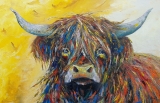The Art World
The radiant canvas: Exploring the significance of yellow in art
In the vast spectrum of artistic expression, the color yellow emerges as a luminous force that captivates the eye and evokes a myriad of emotions. From the golden glow of sunlight to the vibrancy of daffodils, yellow has played a significant role in art throughout history, transcending cultural and temporal boundaries.
Yellow, often associated with the warmth of sunlight, serves as a symbol of positivity and energy. Artists harness its radiant hues to infuse their creations with a sense of optimism and joy. The works of Vincent van Gogh, notably "Sunflowers," exemplify how yellow can convey the vibrant essence of life, becoming a visual embodiment of happiness.
Highland cow. Marina Daniluka
Being one of the most attention-grabbing colors, holds expressive power in the hands of artists. Its bold and dynamic nature ensures that artworks featuring yellow elements immediately command attention. Henri Matisse's use of yellow in his fauvist works showcases how the color can be employed to create visual intensity and emotional impact.
Tags: Buy holiday art gift vouchers
In various cultures, yellow carries diverse meanings and symbolism. In Western cultures, it often symbolizes warmth and positivity, while in Eastern cultures, it can signify courage and spirituality. The use of yellow in religious art, such as the golden halos in Byzantine icons, reflects its association with divine light and enlightenment.
Yellow's versatility lies in its ability to both harmonize and contrast with other colors. When paired with complementary colors like violet or blue, yellow can create striking visual contrasts. On the other hand, its use alongside analogous colors like orange and green can produce harmonious and balanced compositions.
The psychological impact of yellow is profound, influencing mood and perception. It is known to stimulate mental activity and promote feelings of warmth and happiness. Artists strategically incorporate yellow to elicit specific emotional responses and enhance the overall atmosphere of their works.
In contemporary art, artists continue to explore the expressive potential of yellow. From abstract works that utilize yellow as a primary element to digital art where yellow pixels create vibrant compositions, the color remains a dynamic and relevant force in the ever-evolving art landscape.
The use of the color yellow in art transcends its visual appeal, delving into the realms of emotion, symbolism, and cultural significance. Whether used to convey the radiant hues of nature, provoke emotional responses, or symbolize profound meanings, yellow stands as a testament to the enduring power of color in shaping the narrative of artistic expression. In the hands of artists, the canvas becomes a radiant playground where the color yellow dances, capturing the essence of light, life, and the boundless possibilities of creative exploration.
.
